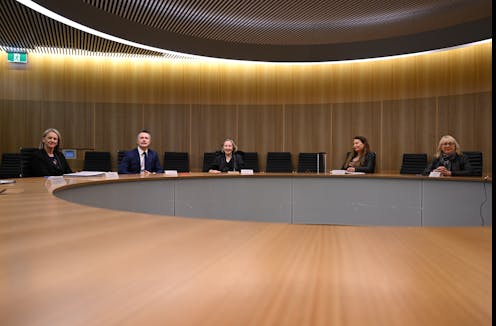
This is shaping up to be an enormously important year for higher education in Australia. The Albanese government is aiming to deliver a historic Universities Accord by December, to create a “visionary plan” for the sector over the next 10 to 30 years.
The accord is underpinned by a review, chaired by former NSW chief scientist Mary O'Kane. On Wednesday, O'Kane launched a discussion paper, calling on stakeholders to come forward with “big ideas” and imploring them to be brave.
What are some of the key issues the accord will need to address?
The discussion paper
O'Kane has noted the “very broad” nature of the accord’s terms of reference. The discussion paper asks no fewer than 49 questions.
This includes questions about how the sector can deliver on national ambitions for skills, jobs and industry-led research. Questions are also asked about systemic problems in vocational education and training and domestic funding shortfalls.
It also raises concerns about the low rates of some groups enrolling in universities, casualisation of the academic workforce, rising costs and how to attract a more diverse range of international students to study in Australia.
Submissions are due back by April 11, with an interim report expected in June.
Read more: The universities accord could see the most significant changes to Australian unis in a generation
Job-ready Graduates
One of the biggest tasks of the accord is proposing models to replace the controversial Job-ready Graduates Package.
Job-ready Graduates was introduced by the Morrison government in 2021. It changed subsidy rates so some courses perceived to have better job outcomes (such as teaching, nursing and maths) received greater government support. Students in courses such as humanities ended up with increased fees.
The policy has been criticised for being ineffective. There is little evidence it is addressing skills needs.
Meanwhile, graduates in many disciplines such as humanities and business, have better employment outcomes than priority courses like science.
There are also perverse incentives for universities to enrol more students in the courses that are being discouraged.
This is because while there are caps on the government-funded contribution, the amount universities receive through student loans remains uncapped. About 90% of funding for courses like arts degrees comes from student loans, meaning universities are encouraged to enrol as many students as they can.
Addressing the inconsistencies created by Job-ready Graduates is a major question for the accord. Though it is unclear what model might replace it, students and universities will be watching it with great interest.
The importance of a skilled workforce
The discussion paper highlights the role of universities in supplying a skilled workforce to support economic growth.
The last major review into the higher education sector in 2008, set a target of 40% of young people with a university-level qualification by 2020. This target has been met.
But the growth in people going to university has come at the expense of TAFEs. In 1986, there were roughly the same number of young people aged 15 to 24 enrolled at vocational education institutions as there were at universities. By 2021, the split was 76% university and 24% vocational education and training.
The mixture of courses is important because about 40% of future jobs growth are in occupations aligned to courses in the vocational education sector. For example, some of the strongest job growth will be in aged care and child care.
The accord has been asked to find ways to have better connections with the vocational sector. This is a particularly difficult task as the vocational education sector is underfunded and in need of reform.
Mitchell Institute research show universities receive almost twice the amount of revenue per domestic students as a vocational institution, such as a TAFE.
While meeting skills needs is a key priority of the accord, creating a cohesive tertiary education system is a major reform agenda that has so far proven elusive.
International education (the elephant in the room)
Revenue from international students has been fundamental to the strength of the university sector over the past two decades.
Before the pandemic, Australian Bureau of Statistics data showed international student revenue grew to 11 times the 2001 level. Enrolments have grown by about four times over the same period.
It is difficult to overstate how important this revenue stream has become. Universities receive two to three times the funding amount for an international student than for a domestic student. This extra funding helps subsidise other activities, particularly research.
But this revenue is concentrated in certain (more prestigious) universities. Many of the smaller and regional universities – with higher levels of disadvantaged students – miss out on this important revenue stream.
With limited opportunities for more government funds, future policies around international education – and how this resource is shared – will be critical for the university sector.
A huge task
So, the accord has a huge task. It must tackle complex and diverse issues, from domestic student funding to the need for clearer links to vocational education, while making the best use of funds from international student fees.
The authors do not work for, consult, own shares in or receive funding from any company or organisation that would benefit from this article, and have disclosed no relevant affiliations beyond their academic appointment.
This article was originally published on The Conversation. Read the original article.







